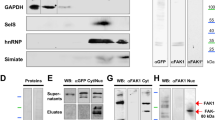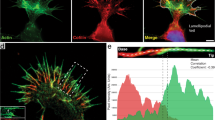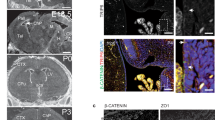Abstract
Precisely regulated radial migration out of the ventricular zone is essential for corticogenesis. Here, we identify a mechanism that can tether ventricular zone cells in situ. FILIP interacts with Filamin A, an indispensable actin-binding protein that is required for cell motility, and induces its degradation in COS-7 cells. Degradation of Filamin A is identified in the cortical ventricular zone, where filip mRNA is localized. Furthermore, most ventricular zone cells that overexpress FILIP fail to migrate in explants. These results demonstrate that FILIP functions through a Filamin A–F-actin axis to control the start of neocortical cell migration from the ventricular zone.
This is a preview of subscription content, access via your institution
Access options
Subscribe to this journal
Receive 12 print issues and online access
$209.00 per year
only $17.42 per issue
Buy this article
- Purchase on Springer Link
- Instant access to full article PDF
Prices may be subject to local taxes which are calculated during checkout







Similar content being viewed by others
References
Anderson, S. A., Eisenstat, D. D., Shi, L. & Rubenstein, J. L. Interneuron migration from basal forebrain to neocortex: dependence on Dlx genes. Science 278, 474–476 (1997).
Tomioka, N. et al. Neocortical origin and tangential migration of guidepost neurons in the lateral olfactory tract. J. Neurosci. 20, 5802–5812 (2000).
Rakic, P. Mode of cell migration to the superficial layers of fetal monkey neocortex. J. Comp. Neurol. 145, 61–83 (1972).
Nadarajah, B., Brunstrom, J. E., Grutzendler, J., Wong, R. O. & Pearlman, A. L. Two modes of radial migration in early development of the cerebral cortex. Nature Neurosci. 4, 143–150 (2001).
Noctor, S. C., Flint, A. C., Weissman, T. A., Dammerman, R. S. & Kriegstein, A. R. Neurons derived from radial glial cells establish radial units in neocortex. Nature 409, 714–720 (2001).
Miyata, T., Kawaguchi, A., Okano, H. & Ogawa, M. Asymmetric inheritance of radial glial fibers by cortical neurons. Neuron 31, 727–741 (2001).
Bayer, S. A. & Altman, J. Neocortical Development (Raven, New York, 1991).
D'Arcangelo, G. et al. A protein related to extracellular matrix proteins deleted in the mouse mutant reeler. Nature 374, 719–723 (1995).
Sheldon, M. et al. Scrambler and yotari disrupt the disabled gene and produce a reeler-like phenotype in mice. Nature 389, 730–733 (1997).
Howell, B. W., Hawkes, R., Soriano, P. & Cooper, J. A. Neuronal position in the developing brain is regulated by mouse disabled-1. Nature 389, 733–737 (1997).
D'Arcangelo, G. et al. Reelin is a ligand for lipoprotein receptors. Neuron 24, 471–479 (1999).
Hiesberger, T. et al. Direct binding of Reelin to VLDL receptor and ApoE receptor 2 induces tyrosine phosphorylation of disabled-1 and modulates tau phosphorylation. Neuron 24, 481–489 (1999).
Senzaki, K., Ogawa, M. & Yagi, T. Proteins of the CNR family are multiple receptors for Reelin. Cell 99, 635–647 (1999).
Trommsdorff, M. et al. Reeler/Disabled-like disruption of neuronal migration in knockout mice lacking the VLDL receptor and ApoE receptor 2. Cell 97, 689–701 (1999).
Dulabon, L. et al. Reelin binds α3β1 integrin and inhibits neuronal migration. Neuron 27, 33–44 (2000).
McConnell, S. K. & Kaznowski, C. E. Cell cycle dependence of laminar determination in developing neocortex. Science 254, 282–285 (1991).
Luskin, M. B. & Shatz, C. J. Neurogenesis of the cat's primary visual cortex. J. Comp. Neurol. 242, 611–631 (1985).
Stossel, T. P. et al. Filamins as integrators of cell mechanics and signalling. Nature Rev. Mol. Cell Biol. 2, 138–145 (2001).
Eksioglu, Y. Z. et al. Periventricular heterotopia: an X-linked dominant epilepsy locus causing aberrant cerebral cortical development. Neuron 16, 77–87 (1996).
Fox, J. W. et al. Mutations in filamin 1 prevent migration of cerebral cortical neurons in human periventricular heterotopia. Neuron 21, 1315–1325 (1998).
Brotschi, E. A., Hartwig, J. H. & Stossel, T. P. The gelation of actin by actin-binding protein. J. Biol. Chem. 253, 8988–8993 (1978).
Gorlin, J. B. et al. Human endothelial actin-binding protein (ABP-280, nonmuscle filamin): a molecular leaf spring. J. Cell Biol. 111, 1089–1105 (1990).
Cunningham, C. C. Actin polymerization and intracellular solvent flow in cell surface blebbing. J. Cell Biol. 129, 1589–1599 (1995).
Glogauer, M. et al. The role of actin-binding protein 280 in integrin-dependent mechanoprotection. J. Biol. Chem. 273, 1689–1698 (1998).
Cunningham, C. C. et al. Actin-binding protein requirement for cortical stability and efficient locomotion. Science 255, 325–327 (1992).
Hatanaka, Y. & Murakami, F. In vitro analysis of the origin, migratory behavior and maturation of cortical pyramidal cells. J. Comp. Neurol. (in the press).
Parent, A. Carpenter's Human Neuroanatomy (Williams & Wilkins, Media, 1996).
Xie, Z., Xu, W., Davie, E. W. & Chung, D. W. Molecular cloning of human ABPL, an actin-binding protein homologue. Biochem. Biophys. Res. Commun. 251, 914–919 (1998).
Yoneda, T., Sato, M., Maeda, M. & Takagi, H. Identification of a novel adenylate kinase system in the brain: cloning of the fourth adenylate kinase. Mol. Brain Res. 62, 187–195 (1998).
Nagano, T. et al. A2-Pancortins (Pancortin-3 and -4) are the dominant pancortins during neocortical development. J. Neurochem. 75, 1–8 (2000).
Lupas, A., Van Dyke, M. & Stock, J. Predicting Coiled Coils from Protein Sequences. Science 252, 1162–1164 (1991).
Acknowledgements
We thank S. Morikubo, S. Funai, H. Yoshikawa, T. Kato, D. Konno, Y. Takamura and M. Maeda for their technical assistance, H. Yagi, K. Ando, T. Nakamura, T. Takami for helpful discussions, Y. Yokota for critical reading and H. Takagi for encouragement. We are also grateful to T. Stossel and Y. Ohta for the human Filamin A cDNA and J. Miyazaki for the pCAGGS vector. Image analysis by confocal microscopy (LSM510) was supported by the Center for Analytical Instruments, National Institute for Basic Biology. This work was supported in part by the Ministry of Education, Culture, Sports, Science and Technology (to M.S. and T.N.), the Kato Memorial Bioscience Foundation (to M.S.) and the Japan Spina Bifida & Hydrocephalus Research Foundation (to M.S.).
Author information
Authors and Affiliations
Corresponding author
Ethics declarations
Competing interests
The authors declare no competing financial interests.
Rights and permissions
About this article
Cite this article
Nagano, T., Yoneda, T., Hatanaka, Y. et al. Filamin A-interacting protein (FILIP) regulates cortical cell migration out of the ventricular zone. Nat Cell Biol 4, 495–501 (2002). https://doi.org/10.1038/ncb808
Received:
Revised:
Accepted:
Published:
Issue Date:
DOI: https://doi.org/10.1038/ncb808
This article is cited by
-
Homozygous loss-of-function variants in FILIP1 cause autosomal recessive arthrogryposis multiplex congenita with microcephaly
Human Genetics (2023)
-
Filamin-A-interacting protein 1 (FILIP1) is a dual compartment protein linking myofibrils and microtubules during myogenic differentiation and upon mechanical stress
Cell and Tissue Research (2023)
-
The diagnostic yield, candidate genes, and pitfalls for a genetic study of intellectual disability in 118 middle eastern families
Scientific Reports (2022)
-
Association between resting-state functional brain connectivity and gene expression is altered in autism spectrum disorder
Nature Communications (2022)
-
Developmental malformations in Huntington disease: neuropathologic evidence of focal neuronal migration defects in a subset of adult brains
Acta Neuropathologica (2021)



